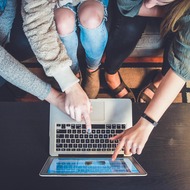
(View Complete Item Description)
Unit OverviewThis unit focuses on the various modes of local, national and world news. Students will read, evaluate and integrate multiple sources of information to gain perspective and understanding of a variety of news events. Through a structured instructional sequence, students will gain knowledge about current news, discuss the events, analyze news sources, identify bias and write brief news articles or reports based on research. The unifying theme, What’s News? will guide students as they discuss the essential question, How does the news influence us?A variety of focus texts and resources are suggested. Depending on your class and available resources, other texts may easily be substituted. Teachers may develop a customized instructional sequence with alternate news articles appropriate to the needs and make-up of the community/school population.It is important teachers prepare fully by reading all resources and consider their students when planning to implement this unit. Time frames may vary depending on the daily amount of instructional time allotted, the student group and the degree of teacher support required for students to meet with success.Teacher Note: The news of today can be very graphic and disturbing. It is important you intentionally select articles and news that do not deal with violence of any kind but that does engage 5th graders. Remember to consciously be aware of this aspect of the news for the general public. Included in this plan are a variety of “kid friendly” news sites to access. You could write a letter to the parents of your class informing them of the unit’s intent and your plan for implementing it. For guidance, watch the TVO video about TKN and Media Literacy video at the bottom of the home page www.teachingkidsnews.com.The lesson models in this unit feature best practices using informational texts to address Common Core State Standards. Included are examples of text dependent questions and sample responses to guide instruction. Students will engage with technology and practice effective listening and speaking skills in collaborative groups to identify key ideas and concepts and to build deeper understanding.Additional Planning and Preparation:Read the entire unit model, associated texts, and resources.Note vocabulary, phrases, concepts, and terminology that may be challenging.Organize the class in groups or pairs for cooperative work and discussion.Access and bookmark web resources your students will use.You many choose to infuse ‘bigger’ questions into discussion such as:What does it take to overcome challenges?How do we face challenges?What kinds of challenges do we face?Are life always challenges necessary to succeed?Universal Design Principles and strategies for English Learners:Organize the class in groups and pairs for discussion and cooperative work.Use multiple modes of presentation to allow acquisition and integration of knowledge and to increase interest and motivation.Offer students choice of tasks and modes of response.Considering using a word processing program or template for students to keep notes such as Google note taking tools.IMPORTANT NOTE: No text model or website referenced in this unit has undergone a formal review. Before using any of these materials, local school systems should conduct a formal approval review to determine their appropriateness. Teachers should always adhere to Acceptable Use Policy enforced by their local school system.Text Models For Lessons and Lesson Seedshttp://teachingkidsnews.comhttps://theconnectedclassroom.wikispaces.com/NewsInterdisciplinary ConnectionsSocial Studies/Geography/Science/Health/Current EventsAdditional ResourcesTeacher ResourcesDaily News at http://www.nwf.orgWashington Post: http://www.washingtonpost.com/local/ecologists-track-dc-ospreys-long-journey-home--from-south-america-to-the-anacostia/2014/04/18/78a5dd18-c3fc-11e3-b195-dd0c1174052c_story.htmlPair these three articles – take down nest, bird rebuilds, rebuild, take down, build platform:http://www.washingtonpost.com/local/osprey-nest-blocking-md-traffic-camera-removed/2014/04/19/64623da8-c7fb-11e3-b708-471bae3cb10c_story.htmlhttp://www.washingtonpost.com/local/md-installs-nesting-platform-for-osprey/2014/04/24/c4c49eda-cbd8-11e3-b81a-6fff56bc591e_story.htmlhttp://www.washingtonpost.com/local/md-considers-nesting-platform-for-ospreys/2014/04/23/b82cf0f0-cb10-11e3-b81a-6fff56bc591e_story.htmlREADWORKShttps://www.readworks.org/passages/new-letter-alphabethttps://www.readworks.org/node/2219 batshttps://www.readworks.org/passages/classical-music-wolfgang-amadeus-mozarthttps://www.readworks.org/passages/cool-be-kind-0https://www.readworks.org/passages/endangered-animals-glancehttps://www.readworks.org/passages/finger-foodhttps://www.readworks.org/passages/homemadehttps://www.readworks.org/passages/meet-soldierScience Fridayhttp://auburnpub.com/science-friday-return-of-the-condor/article_54c3335a-cc67-11e3-acda-001a4bcf887a.htmlTime for Kids https://www.timeforkids.com/NIEhttp://www.washingtonpost.com/lifestyle/kidspost/http://helenair.com/news/local/th-graders-keep-abreast-of-current-events-school-issues/article_8dad9ea4-cc39-11e3-8e63-001a4bcf887a.htmlhttp://www.nwf.org
Material Type:
Lesson Plan
Authors:
andrew robertson,
MSDE Admin




















